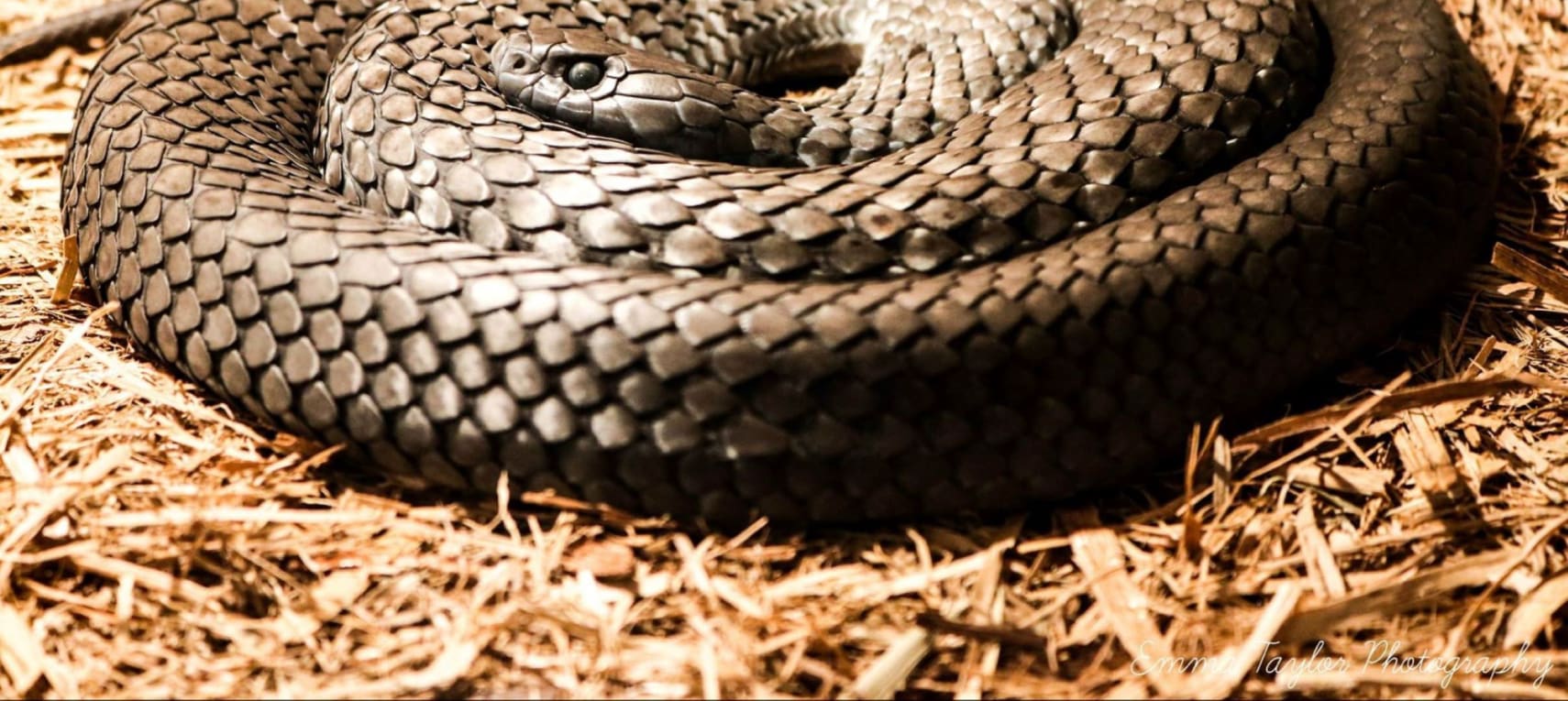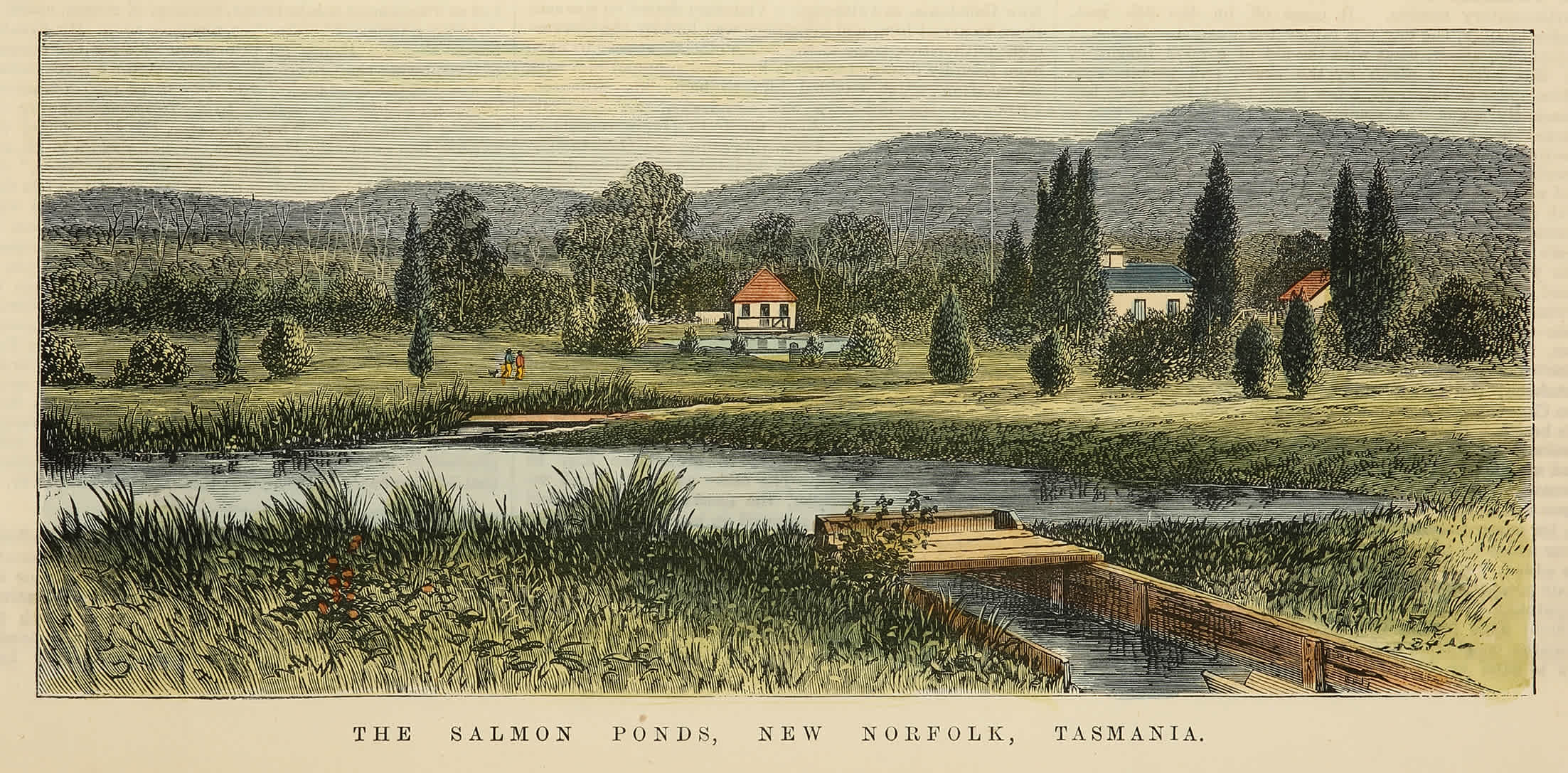photographer EMMA TAYLOR
It’s now not uncommon for snakes to be sighted mid-winter, whereas 15 years ago we pretty much stopped getting callouts by March. ~ Veronika Ross
It’s a typical cool spring morning in Veronika Ross’ kitchen. She’s got a brew on the go and is smiling affectionately at the convalescing creature peering inquisitively at us from his enclosure – a tiny caramel and chocolate striped tiger snake named Garth. Garth came into Ross’s care via Bonorong Wildlife Sanctuary after being attacked by a goose (yes, you read that right) and needing surgery to repair his badly damaged tail. It’s just a typical day at Snakes Alive Tasmania, her snake relocation, rehabilitation and education business. As we sip our herbal concoctions and admire Garth’s dashing good looks, conversation moves to where we’ve already seen snakes active in recent weeks, and to the close-knit community of Tasmanian reptile enthusiasts and professionals who share knowledge with one another. She says that in recent years, they’ve collectively been noticing some trends in reptile health suggestive of a threat more concerning than ill-tempered geese.
“I don’t know whether it’s La Niña or climate change more broadly,” she muses, “but there’s definitely been an increasing number of sick snakes coming in.”
Veronika’s “hospital” is indoors so she can better control the reptiles’ environment and feed them over winter, giving them a head start prior to release. She explains that with the ground being increasingly sodden, they were getting “colds” and mouth rot over the winters, which she says have become warmer and wetter than average – ideal conditions for fungal growth. When such fungus infects the mouth scales, it can have a profound effect on a reptile’s hunting ability, ultimately resulting in starvation.
Ross has had to adapt their enclosures in the face of wetter summers too, installing tin floors and elevating the enclosures to increase airflow.
“It’s now not uncommon for snakes to be sighted mid-winter,” she says, “whereas 15 years ago we pretty much stopped getting callouts by March. Back when I started, we didn’t see a noticeable increase in calls until late October. The reptiles also aren’t getting cold enough to torpor (hibernate) properly now. They’re thin and lose a lot of condition, which in turn makes them less capable of hunting and therefore less likely to survive until they can make a kill, or even digest it properly if they do.”
She shows me a photograph of a snake seen in the open in mid-July at Fortescue Bay. Even to my untrained eye I can see that it’s not in good shape, with the spine and many rows of ribs easily visible.
The next picture, snapped by a couple of bushwalkers on the Overland Track, is of a lowland copperhead snake curled up under a snow-laden bush. Something about snow and snakes side by side just doesn’t look right.
Garth loses interest in us when it seems breakfast is not arriving, and turns his head away from the glass. Apart from the tardy room service and a still-healing tail, he seems otherwise content in his recuperative digs. As I survey the various reptiles, Ross motions to me with the universally understood signal for quiet. The guests in her Japanese-style pod hotel are mostly those she was summoned to relocate from someone’s porch or garden shed, but were found to be too unwell for immediate release. Some have patches of what appear to be rotting scales, some have wounds, and others just look thin and decidedly sleepy. All are in need of a little of Veronika Ross’s TLC.
A full recovery is looking hopeful for Garth, but even if he makes it back to the wild, it’s an uncertain future out there too.

Human-induced climate change is now an almost universally accepted truth. However, understanding of how climate change will affect complex systems at a local level continues to evolve.
The University of Tasmania’s Dr Amelie Meyer, a chief investigator at the Centre of Excellence for Climate Extremes, tells me they have quantified a measurable shift in Tasmania’s seasons of about one and a half days each year, with spring starting progressively earlier. The Intergovernmental Panel on Climate Change (IPCC) further warns that winter temperatures are rising at a faster rate than summer temperatures and that Tasmanian rainfall patterns will also continue to change over the next 20-30 years, with a substantial increase in winter rainfall. It seems likely this is not good news for Tasmanian reptiles in need of somewhere dry to wait out the winter.
Just like the northern hemisphere’s hibernating bears, snakes become inactive over the cooler months, retreating into hollow logs, abandoned animal burrows and tree stumps, sometimes curling up together in large numbers. Being ectothermic (animals whose body temperature and metabolism are determined by environmental temperatures), reptiles go into this state of metabolic torpor over winter to conserve energy. With winters not being as cool however, if temperatures don’t drop sufficiently during torpor, a snake’s metabolism will tick over at an unsustainably high rate, using up precious body reserves.
More warmer days may also coax reptiles briefly out of hibernation more often, which is unlikely to be in their best interests. Where such events are not warm enough or long enough for snakes to hunt successfully, it merely depletes already low body reserves and leaves them unable to hunt or feed. Judging by the reports of snake catchers, this predicted scenario is already playing out, but there is clearly opportunity for further research to better understand the complexities.

Curiously, warmer average conditions might in fact be favourable for Tasmanian snakes. Being tied to environmental temperatures is generally beneficial during summer, when warm days equate to increased metabolism and activity, meaning snakes are well equipped to hunt on such days, especially darker coloured individuals. Given the obvious survival advantage of being as heat-absorbent as possible in a comparatively cool climate, it’s no surprise that a higher proportion of darker morph tiger snakes have evolved in Tasmania, through natural selection.
Being ectothermic of course means that snakes can also overheat, potentially an increasing concern in a climate with more extreme heat days. Whilst it’s unlikely that a warmer climate would open up new habitat (as snakes already occur statewide), it could shorten dormancy, shift the timing of reproduction and influence activity. Shorter winters and more days of extreme heat could see snakes being active for longer, and also lead to more human-snake interactions (for example, as snakes move about more in search of water).
Tasmanian reptiles already live at the cooler end of their possible temperature range, therefore any climate-induced changes to survivability, biology or behaviour are likely to be noticed here first. Tasmanian snakes and lizards may thus prove to be the canaries in the coalmine for Australia’s unique reptile fauna in the face of a changing climate. Amelie Meyer explains that whilst research has clearly identified direct climate change effects in Tasmania’s marine environment, such as receding giant kelp forests and southerly expansion of long-spined sea urchins, there seems to be comparatively little research into temperate terrestrial fauna responses to climate change.
The informal observations of wildlife carers like Natalie Rivers, the founder and former manager of Tasmanian Animal Rescue, Rehabilitation and Education Services, however, back up the IPCC’s assertions and support Veronika Ross’s observations. “Winters have certainly been warmer and wetter and we’re seeing a lot of scale rot. The snakes that come into care are sometimes so malnourished, we’ve a job just to get them eating so they can start to recover,” Rivers says.
Whilst the direct links between climate and local reptile responses remain unclear, several Tasmanian ecological communities are known to be particularly susceptible to temperature shifts. Species dependent on these habitats, such as a number of alpine dwelling skinks, are therefore considered to be at high risk. The University of Tasmania’s Dr Geoff White, senior lecturer in behavioural and evolutionary ecology, is researching skinks as a model to look at the effects of environmental change on reptile biology, distribution, breeding and behaviour. His research is conducted on the accessible slopes of Hobart’s kunanyi, looking at low elevation spotted snow skinks (Carinascincus ocellatus) and metallic skinks (Carinascincus metallicus), and their highland counterparts, southern snow skinks (Carinascincus microlepidotus). For such easily overlooked critters, early data suggests they may have some big tales to tell.
The distribution of these skinks is defined by temperature, meaning that lowland and alpine species are differentiated altitudinally, with about 50 metres of vertical range overlap. Whilst southern snow skinks have dibs on real estate above 1,100m, and the associated advantage of exclusive access to top-shelf grub, there is also a cost. When everything you do is temperature-dependent, life happens a bit slower in the cold, including embryonic development, gestation length and the timing of ovulation. Breeding success is therefore very much linked to ambient temperatures.
Southern snow skinks conserve resources and maximise survival by breeding half as often as lowland species (biennially, rather than annually). Moreover, they hang onto live young inside their bodies until spring, when there’s a higher chance of surviving the harsh conditions into which they’re born. The risk, however, is that during warmer years, the faster breeding lowland species may move up to higher elevations and out-compete their alpine cousins. Lowland skinks already out-compete southern snow skinks for basking sites where the species overlap, suggesting that any tenuous competitive advantage held by alpine skinks is down to their ability to better tolerate the cold, an increasingly fragile foothold in a warming climate. Researchers believe that over the past fifteen years, the altitude point at which the species transition has moved further up kunanyi, and there’s no reason to suggest a similar pattern would not be occurring on mountains elsewhere.
Scientists everywhere are in a race against the pace of climate change to unravel its effects on various species and systems. Dr White says much of his findings and observations regarding the interaction between climate and local skink populations can be extrapolated to other ectotherms. Like alpine skinks, all three species of Tasmanian snakes (tiger, lowland copperhead and white-lipped) are viviparous, meaning that they give birth to live young rather than lay eggs. “We’re noticing obvious changes in the overall breeding success of snakes,” says Natalie Rivers, “with snakes giving birth later in the season, and sometimes the young are born dead.”
Such observations by vigilant carers are valuable anecdotal evidence of change and a key input into the direction future research may take. Rivers has recently handed over the reins of her wildlife business to pursue a career in biological science. Perhaps it will be her who finds the next piece in Tasmania’s ecological climate puzzle. Either way, it seems Garth and his friends have a fighting chance in an uncertain world, thanks to the community of scientists, wildlife carers, snake wranglers and observant bushwalkers all sharing and collaborating on their behalf.
Sonia Strong moved to Tasmania in 2005 and lives in the forested hills of the D’Entrecasteaux Channel. She has worked in conservation and alpine/marine park management, as a paramedic and recently, as a wilderness ranger. She is also a metalsmith, writer and painter. She has a deep affection for windswept and interesting people and places and is happiest when creating, immersed in a creek looking for sapphires, exploring wild places or in the sunshine with wine and friends. Sonia has published several children’s books through Forty South, including “Tazzie The Turbo Chook Finds Her Feet”. You can follow her on Instagram, @soniastrongartist.








